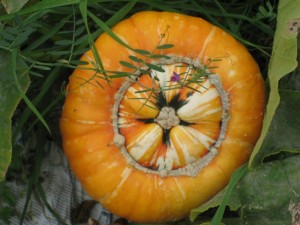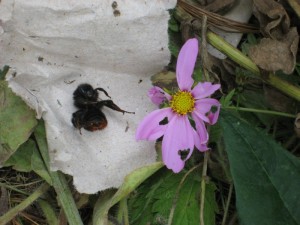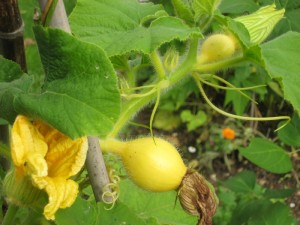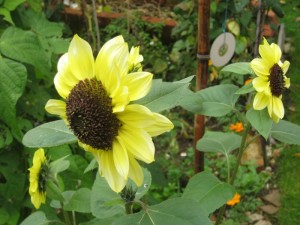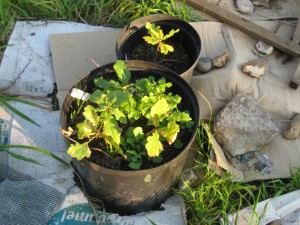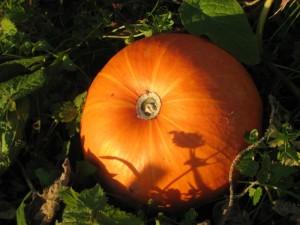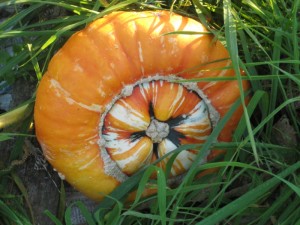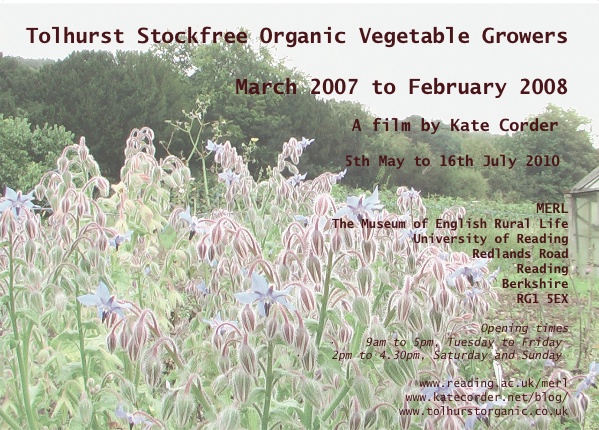20th September 2011 – Allotment Plot 326 – Harvest: Oriental Greens Tai Sai = 2oz = 50g; 1 x Courgette Patriot F1 = 12oz = 350g; 1 x Squash Green Hokkaido = 6oz = 170g; 1 x Squash Green Hokkaido = 13oz = 370g; 1 x Squash Green Hokkaido = 1lb 2oz = 510g; 1 x Squash = 1 x Squash Red (Uchiki) Kuri = 10.5oz = 300g; 1 x Squash Red (Uchiki) Kuri = 10oz = 290g; a mix of Beans (Climbing and Runner) = 7.5oz = 210g.
22nd September 2011 – Allotment Plot at MERL – The sound of a lawn mower machine erupted close to the Plot. The driver drove the small tractor like object around in circles. The grass did not look like it needed to be cut, but the driver was programmed to automatically follow instructions from a higher level even if this meant abandoning an initiative to abort the cut grass operation if the grass was deemed not long enough to warrant cutting. On the radio* that morning there had been a conversation about the size of the ice sheet at Greenland as represented in a new atlas (The Times Atlas). This discourse it seemed had been happening in the media for several days. The concern was whether or not the ice sheet was depicted accurately or inaccurately in the new edition of the atlas. It was felt that demise of the ice was over exaggerated, but at the same time the depletion of ice and snow was a cause for alarm, an ecological change and evidence of the Hyperobject, global warming. Whether or not the atlas is accurate or not, Greenland is becoming more green, and less white. The obsession with the grass lawn as an object that needs to be trimmed on a regular basis contributes to the hyperobject, (along with a high proportion of other human activities), which results in the depletion of the ice and snow on Greenland and the rise in sea levels.
Ella Montt shifted her gaze away from the mower and searched the garden for any signs of the Chaffinch or Greenfinch birds, but there was none immediately to be found. These two taxonomic groupings of birds are in serious decline due to an outbreak of trichomonosis parasite in birds since 2005**. It would be safer for these birds to feed from seeds growing in the garden, rather than from a communal bird feeder, so Ella Montt prepared to leave many of the Companion Planting seeds as part of the Plot and a source of food for the birds as “naturally” occurring bird food as opposed to bird feed that had been placed in a feeder for the birds, where parasites can multiply and spread the disease.
(* & ** BBC Radio 4 Today program)
When the mower machine was gone Ella Montt found a dead bee lying on the grass next to the Plot. The time of this particular bee’s death was unknown and the reason of death also unknown. The bee was not squashed or mangled, but it was dead. Ella Montt removed the bee corpse to the Brick Composter to prepare for the bee’s body’s decomposition. The Carrot crop was harvested. The crop was a dismal failure. Another female flower was appearing on the healthy Squash Plant.
Harvest: Companion Planting seeds, Chamomile, Calendula Pot Marigold, Cosmos Cosmea and Sunflower = 1oz = 20g; Tomatoes = 1lb 4oz = 560g; Rainbow Chard = 2oz = 50g; Carrots = 3oz 90g; Beans (Runner) Enorma = 11oz = 320g; Beans (French Climbing) Blauhide = 2oz = 50g; Neckarqueen and Blue Lake 6oz = 175g.
29th September 2011 – Allotment Plot at MERL – The day after the Cultivation Field Postgraduate Symposium, Ella Montt sat resting in the shade of the Mulberry Tree. The weather had become warm again and was about to reach record breaking temperatures in the UK for the time of year. The sunshine and warmth was without a doubt universally beautiful to human beings (even Kant agreed). The plants that had begun to decline and fade with the Autumnal downward spiral towards death also appreciated the warm weather and started a burst of new vigor and unexpected growth. The Sun was prolonging the growing season. The danger of frost was temporarily halted, but will resume again later. It seemed a long time since the warm weather in April and summer had been rather cold. There appeared to be two Squashes growing on the most healthy Squash plant, and a fourth female flower developing, but the plant growth would need to accelerate in order to reach fruition (the first female flower did not bear fruit). Ella Montt was gazing in to her Crystal Ball and although the reading was hazy, she had a strong sense that there will be early snow in November, but this could be just residue of a memory left in the Crystal Ball from last year.
Harvesting was about to commence. The Barlotta Di Fuoco Beans were left to mature in to more substantial Beans. The Celery was also left to continue its growth. There were some unexpected happenings on the Plot, because of the warmth of the Sun that was allowing the plant growth regeneration. A Sunflower plant was flowering prolifically with multiple blooms.
Harvest: Companion Planting Seeds, self-seeded Nigella, Calendula Pot Marigold, Cosmos Cosmea = 1oz = 20g; Tomatoes = 6oz = 170g; Beans (Runner) Enorma = 1lb 2.5oz = 525g; Beans (French Climbing) Blauhide 1.5oz = 45g, Neckarqueen = 2oz = 60g.
30th September 2011 – Allotment Plot 326 – The warm weather was continuing. Harvest: Perpetual Spinach = 4.5oz = 135g; Kale Red Russian Curled = 1.5oz = 45g; Oriental Greens Tai Sai = 4oz = 110g; Chard = 4.5oz = 130g; Beans (Runner) Enorma = 10oz = 280g; Beans (French Climbing) Neckarqueen = 9oz = 250g, Blauhide = 1oz = 25g; Beans (French Dwarf) Royalty = 1oz = 25g; 1 x Courgette Patriot F1 = 12oz = 340g; 1 x Squash Blue Kuri = 1lb 13oz = 820g; 1 x Squash Green Hokkaido = 1lb 12oz = 790g.
The Oak Tree seedlings continued to grow in pots.
2nd October 2011 – Allotment Plot 326 – The warm weather still continued. Harvest: 1 x Pumpkin Cinderella = 5lb 9.5oz = 2.55Kg; 1 x Squash Turks Turban = 5lb 15oz = 2.7Kg; 1 x Squash Blue Kuri = 2lb 7oz = 1.11Kg; 1 x Courgette Patriot F1 = 4oz = 100g; 1 x Cucumber Tanja = 11oz = 310g.

